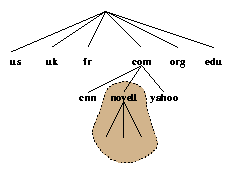
Domains are structured in the form of an inverted tree. Each branch or leaf on the tree is labeled with an simple alphanumeric string, and a complete domain name is written by stringing all the labels together, separated by periods. Thus, www.cnn.com is a third-level domain name. The root domain is com, the second level label is cnn, and the third level is www. Incidentally, there is no standard way to visually distinguish a branch from a leaf. In fact, the Internet domain system makes no distinction between the two, since branches can have any attributes of a leaf, and leaves can have children added to them and become branches.
The diagram below illustrates the novell.com domain. The interpretation of domain names ending in novell.com is solely at the discretion of Novell. They manage the shaded area of the domain name space.

As documented in RFC 1591, top-level domain names take one of two forms. First, they can be generic domains, all of which are populated by predominately American domains. Alternately, a top-level domain can be a UN two-digit country code, listed in ISO-3166, the most common form for non-American domains.
Generic Domains Country Domains
(partial list)
com - Commercial uk - United Kingdom
edu - Educational fr - France
org - Non-profit Organizations de - Germany
net - Networking Providers nl - Netherlands
mil - US Military us - United States
gov - US Government au - Australia
int - International Organizations ax - Antarctica
To make use of domain names, they must be converted into 32-bit IP Addresses. This is done using the DNS Protocol.
Domain name registrations are handled by InterNIC in North America, RIPE in Europe, and APNIC in Asia. Domain name assignment is completely distinct from IP address assignment.